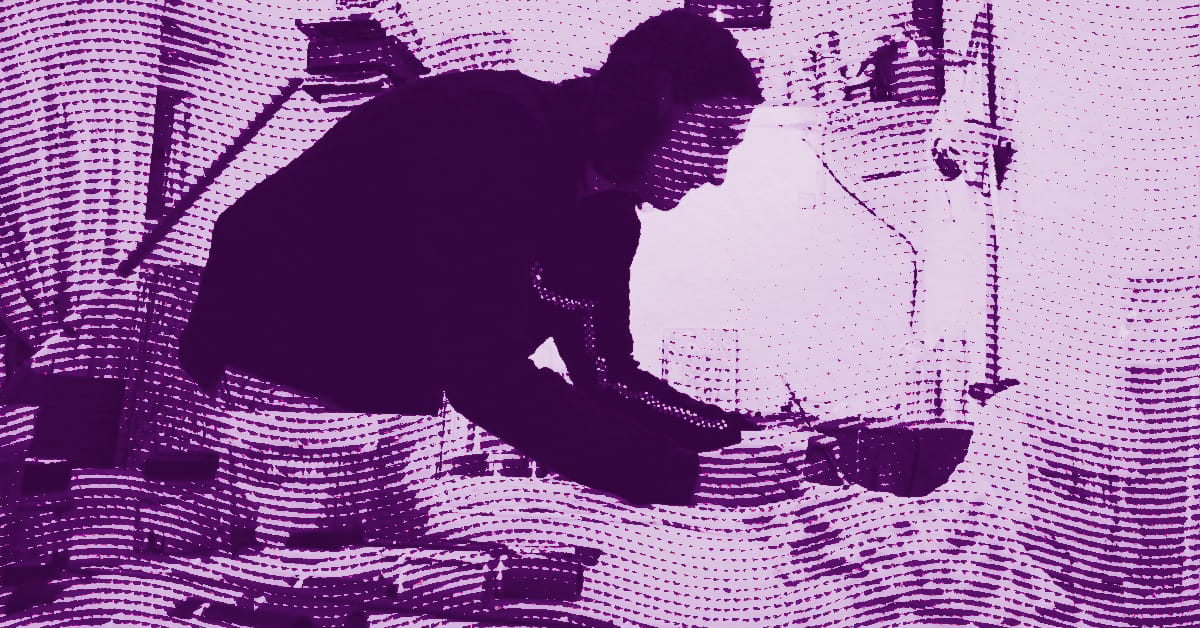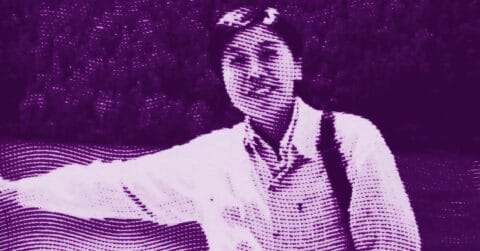Listen to me carefully, you bunch of snobs: Tony Tafuro is not the kind of artist you expect at the quiet openings in Chelsea. This New York native, a Parsons graduate in 2012, makes his way through the forbidden territories of contemporary art with the controlled violence of a skater attacking a ramp. Photographer turned painter, creator of hand-painted clothing, digital artist who inscribes his works on the Bitcoin blockchain, Tafuro embodies this generation of artists who refuse to be confined to a single discipline.
His artistic journey reveals a constant: the exploration of liminality between the real and the fictional, between documentation and pure creation [1]. From his early photographic works documenting skate and underground metal culture to his recent forays into Bitcoin Ordinals sold at Christie’s in April 2024, Tafuro develops a visual language that draws from the iconography of counter-culture to create a personal and coherent universe.
The alchemy of creative destruction: Nietzsche and the philosophy of chaos
Tony Tafuro’s work finds its philosophical roots in Nietzschean thought of creative destruction. This approach is particularly evident in his series “Barrier Kult,” where he photographs masked skaters in an aesthetic that evokes both satanic rituals and pure bodily expression. As Nietzsche stated in “The Birth of Tragedy,” art is born from the tension between the Apollonian and the Dionysian, between order and chaos [2].
Tafuro seems to have internalized this fundamental dialectic. His works constantly oscillate between structure and deconstruction, between documentary precision and gestural abstraction. In his book “Where Ya’ At,” which he describes as “analog captures of life and death through the real and digital world,” the artist manifests this Nietzschean will to grasp the totality of human existence, including its darkest and most contradictory aspects.
Nietzsche’s influence is also revealed in the approach Tafuro has developed towards traditional artistic value. His project “Ordinal Maxi Biz,” created in collaboration with ZK Shark, perfectly illustrates this “transvaluation of all values” dear to the German philosopher. By encouraging the destruction of CryptoPunks to obtain spots on a waiting list, Tafuro operates a radical critique of established hierarchies in the digital art world. This iconoclastic approach recalls Nietzsche’s famous formula that “one must have chaos within oneself to give birth to a dancing star.”
The philosophy of eternal return finds particular resonance in Tafuro’s artistic practice. His photographic series obsessively revisit the same themes, urban violence, marginality, group rituals, as if the artist sought to exhaust the possible variations of a given motif. This compulsive repetition is not out of ease but a will to dig down to the existential foundations of his subjects.
Tafuro’s aesthetics, with its violent contrasts between light and darkness, its unbalanced compositions and its brutal framing, materializes this Nietzschean conception of art as a vital force capable of justifying existence. Each image seems to carry within it this “will to power” that transforms suffering into beauty, chaos into artistic form. In his recent works exhibited at the Palo Gallery at the end of 2022 under the title “Sword In Stone” [3], this philosophy finds its most accomplished expression: the intense colors and expressive gestures testify to an existential urgency that refuses any compromise with bourgeois mediocrity.
The architecture of the ephemeral: Building in instability
The second fundamental dimension of Tafuro’s work stems from a paradoxical architectural conception: how to build permanence with ephemeral materials? This question runs through his entire production, from his first photographic prints to his recent blockchain inscriptions. The artist develops an approach that borrows from the principles of deconstructivist architecture while adapting them to the specifics of contemporary art.
His photographic installations and artist books function as temporary architectures, spaces that the viewer traverses mentally and physically. The “Anonymous” series, which documents the demonstrations of the hacktivist collective, reveals this architectural sensitivity: Tafuro does not merely document the event, he constructs a narrative space where Guy Fawkes masks become the pillars of a cathedral of resistance.
This architectural approach also manifests itself in his editorial practice. Tafuro has published several books with prestigious publishing houses like PowerHouse, but also with independent structures like S_U_N_ Editions. This editorial diversity testifies to a fine understanding of the different “spaces” for the dissemination of contemporary art. Each book functions as a specific building, designed for a particular audience and context.
Tafuro’s architecture draws on the codes of wild urbanism and the temporary occupation of spaces. His photographic compositions organize space according to principles reminiscent of urban guerrilla tactics: rapid occupation, maximum impact, disappearance. This aesthetic of the ephemeral finds its logical culmination in his digital works inscribed on blockchain, where technological permanence marries the economic instability of digital art markets.
The architectural dimension of his work is particularly revealed in his series “NYC Gassholes,” where he makes rubbings of New York sewer grates. These works transform the city’s underground infrastructure into artistic material, revealing the hidden beauty of urban foundations. Through this simple yet radical gesture, Tafuro operates an inversion of spatial hierarchies: what was invisible becomes visible, what was functional becomes aesthetic.
His recent paintings continue this architectural logic by playing with the superposition of pictorial layers. Like an architect revealing the structure of a building, Tafuro lets appear the different stages of creation of his canvases. This transparency of the creative process transforms each work into an architectural section, revealing the temporal strata of its conception.
The territory of the in-between
Tony Tafuro has succeeded in creating a unique artistic territory by refusing the established boundaries between disciplines. His practice reveals a profound understanding of contemporary mutations of art, where photography dialogues with painting, where craftsmanship meets blockchain technology, where popular culture feeds the most demanding aesthetic reflection.
The artist manipulates the codes of counter-culture, skate, punk, metal, hacktivism, not out of nostalgia or superficial appropriation, but to reveal their poetic and political charge. His photographic series document these worlds with the precision of an ethnologist, but his framing and aesthetic choices reveal an artist’s vision that transforms the document into fiction, testimony into creation.
This ability to navigate between different aesthetic registers without ever losing his artistic coherence constitutes Tafuro’s main strength. Whether he works on canvas, textile, paper, or blockchain, his signature is immediately recognizable: this constant tension between control and letting go, this raw energy channeled by remarkable formal intelligence.
His recent exhibitions in Tokyo and his participation in Christie’s auctions [4] mark a new stage in his career. Tafuro succeeds in the difficult challenge of making the most contemporary art dialogue with the most established institutions, without ever denying his underground origins. This tightrope walker position allows him to occupy a unique place in the current artistic landscape.
Tony Tafuro’s work confronts us with an obvious truth: the most vital art is always born on the margins, in those interstitial spaces where certainties waver and experimentation becomes a necessity. By refusing to choose between tradition and innovation, between craftsmanship and technology, between elitism and popular culture, Tafuro invents a new form of artistic radicality, perfectly adapted to the contradictions of our time.
In an art world often paralyzed by academicism or gratuitous provocation, Tony Tafuro proposes a third way: that of the total artist who fully embraces the paradoxes of his time to make them the raw material of his creation. This approach, both fresh, pragmatic, and visionary, already places Tafuro among the most promising voices of his generation.
- Jon Feinstein, “Making Sense of Anthony Tafuro’s Brilliantly ‘All-Over-The-Place’ Photography”, Hafny, 2018
- Friedrich Nietzsche, The Birth of Tragedy, translated by Philippe Lacoue-Labarthe, Paris, Gallimard, 1977
- “Tony Tafuro – Sword In Stone”, Press Release, Palo Gallery, New York, November 2022
- Nicole Sales Giles, interview with CoinDesk, April 2024, quoted in “Why Christie’s First Bitcoin Inscriptions Auction Matters”
















